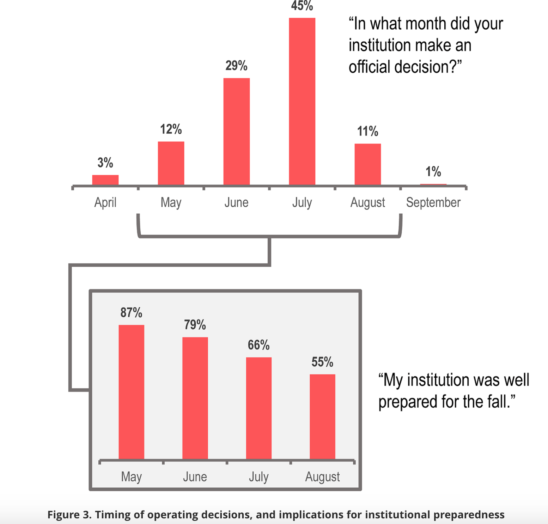
McCormack, M. (2020) EDUCAUSE QuickPoll Results: Fall Readiness for Teaching and Learning, EDUCAUSE Review, September 18
The studies of institutions’ plans, preparation and successes or failures in moving to remote or online learning continue to come in. (See here for a list of research studies since April, 2020). This study reflects mainly IT administrators’ views of what has been going on in the period May to September, 2020.
I’m sorry to repeat this, but I am providing only a taste of the report. If this interests you, please go to the original study.
The EDUCAUSE survey
This was a poll of EDUCAUSE members. EDUCAUSE is a community of IT leaders and professionals. Although based in the USA, EDUCAUSE has over 100,000 individuals at member organizations in approximately 50 countries, serving over 14 million students.
Methodology
This study was an EDUCAUSE QuickPoll, which are less formal than EDUCAUSE survey research. QuickPolls gather data in a single day instead of over several weeks, and are distributed by EDUCAUSE staff to relevant EDUCAUSE Community Groups.
The poll was conducted on September 15, 2020, consisted of 11 questions, and resulted in 487 complete responses and 70 partial responses. Poll invitations were sent to participants in EDUCAUSE community groups focused on IT leadership and instructional technology. Most respondents (475) represented US institutions. Respondents from Canada, Asia, and the UK also participated, but not in sufficient numbers for individual national reports.
The study was focused on institutional readiness for the fall semester, 2020.
Main results
- Better prepared
Summer planning and preparation, particularly in the areas of online course design and instructional support, have resulted in a renewed optimism among respondents that their institutions and faculty are much improved in their online capabilities and far more prepared to meet the challenges of the new academic year…..
Most of our respondents agreed that their faculty are now more prepared for online teaching than they were in the spring and that online education at their institution has noticeably improved….
Of course, it remains to be seen (and cannot be determined through these data) whether these perceived improvements translate into improved experiences and learning for students themselves or into improved long-term institutional outcomes.
2. Early and flexible decision-making is better
Those institutions making fall operating decisions earlier in the summer … benefitted from more time to plan and prepare and therefore feel more ready for the fall term compared with institutions making decisions later.
The main month in which ‘official’ decisions were made about the fall term was July (45%). However the earlier the decision (between May and August) the more prepared institutions were for the fall. This is important, because of the dynamic situation of Covid-19 over this period.

Flexibility is also needed – a willingness to change if necessary – but early planning is still better than ‘wait and see’. Few respondents agreed that their planning activities [for the fall] had been wasted, misguided, or difficult.
3. Planning activities that helped
a. Improving instructional support: many institutions devoted their summer months to closing that gap between “remote” and “online” learning, with their summer planning and preparations focused squarely on online and instructional improvements. This meant focusing on
- improving the use of instructional tools (83%)
- increasing work with instructional/learning designers/online class design (76%)
although a range of other services/activities were also improved by fewer institutions (such as improving online student services (57%).
4. Areas still in need of improvement
a. Internet and technology access remains a problem
Less than half of respondents agreed that they are better prepared to support student internet access now than they were in the spring. Institutions could devote more attention and investment to improving student and faculty internet access. Only a third of respondents indicated that their institution had focused on this issue over the summer months, and less than half of respondents felt that their institution was better prepared to support student internet access now than in the spring.
b. Longer-term investments need to be made
Longer-term and sustainable advancements in these areas will require substantial investments on the part of the institution. In particular, we know that reskilling and expanding the institution’s workforce is a critical component to digital transformation at the institution, and yet few respondents in this survey reported that their institution had been increasing or reallocating staff to support the demand for online learning and instructional improvements.
c. Faculty acceptance of online learning
…some faculty still have a long way to go toward adapting to online education and that some still require coaxing to learn new tools and rethink how they approach their work.
Comment
This is a useful study which indicates institutions (or at least those with respondents to the survey) are doing their best under difficult circumstances. However, the sample size is quite small, given the number of members of EDUCAUSE, and these will be those most invested in instructional technology, so there is a possibility of heavy bias in the responses.
It does show though that early but flexible decision-making can make a difference, but there is still a long way to go to get to a fully satisfactory, system-wide, online experience.









 Dr. Tony Bates is the author of eleven books in the field of online learning and distance education. He has provided consulting services specializing in training in the planning and management of online learning and distance education, working with over 40 organizations in 25 countries. Tony is a Research Associate with Contact North | Contact Nord, Ontario’s Distance Education & Training Network.
Dr. Tony Bates is the author of eleven books in the field of online learning and distance education. He has provided consulting services specializing in training in the planning and management of online learning and distance education, working with over 40 organizations in 25 countries. Tony is a Research Associate with Contact North | Contact Nord, Ontario’s Distance Education & Training Network.

